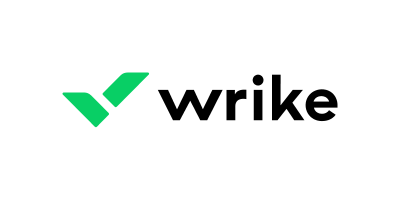[ad_1]
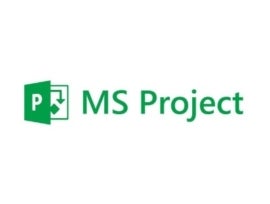
Microsoft Project is a project management solution that offers both cloud-based and on-premises solutions. It is more advanced than Microsoft Planner, Microsoft’s other project management solution, and offers many different features for power users.
For more information, read our full Microsoft Project review.
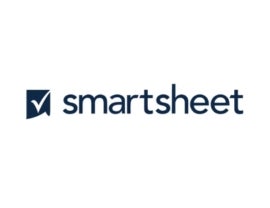
Smartsheet is a cloud project management solution that mimics the look and feel of a spreadsheet. With over 10 million users around the world, Smartsheet boasts that it’s trusted by more than 90% of Fortune 100 companies for their project management needs.
For more information, read our full Smartsheet review.
Jump to:
Microsoft Project vs. Smartsheet: Comparison table
| Software | Microsoft Project | Smartsheet |
|---|---|---|
| Document management | No | Yes |
| Communication tools | No | Yes |
| Time tracking | Yes | Yes |
| Reporting | Yes | Yes |
| On-premises deployment | Yes | No |
| Free plan | No | Yes |
| Starting price for paid tiers | $10 per user per month, billed monthly | $7 per user per month, billed annually |
Microsoft Project and Smartsheet pricing
Microsoft Project pricing
Microsoft Project offers five total plans: three for the cloud-based subscription, and two for the on-premises solution.
On the cloud-based subscription front:
- Project Plan 1 costs $10 per user per month.
- Project Plan 3 costs $30 per user per month.
- Project Plan 5 costs $55 per user per month.
Microsoft Project does not offer a forever free plan, but it does provide a 30-day free trial for the cloud-based solution, so you can try before you buy.
As for the on-premises solutions:
- Project Standard 2021 costs $679.99 for a license for one PC.
- Project Professional 2021 costs $1,129.99.
Microsoft also offers a more flexible, scalable Project Server plan, but you must contact them for a pricing quote.
SEE: Check out these top Microsoft Project alternatives to see if there’s a tool that better fits your needs and budget.
Smartsheet pricing
Meanwhile, Smartsheet offers four total plans:
- The forever Free plan includes one user and up to two editors and sheets.
- The Pro plan costs $7 per user per month, billed annually, or $9 per user billed monthly for up to 10 users.
- The Business plan costs $25 per user per month, billed annually, or $32 per user billed monthly for unlimited users.
- Enterprise includes even more features, but potential customers must contact Smartsheet for a quote.
Smartsheet offers a 30-day free trial of the Business plan, so you can try most of the features before you commit.
Feature comparison: Microsoft Project vs. Smartsheet
Project management
Microsoft Project offers three main project views: grid, board and timeline (Gantt) view (Figure A). The interface is similar to other Microsoft products, and reports are highly customizable. The tool gives you the option to get detailed with resource management, such as tracking costs of materials over the course of a project or seeing how much time an individual has spent on a task.
Figure A
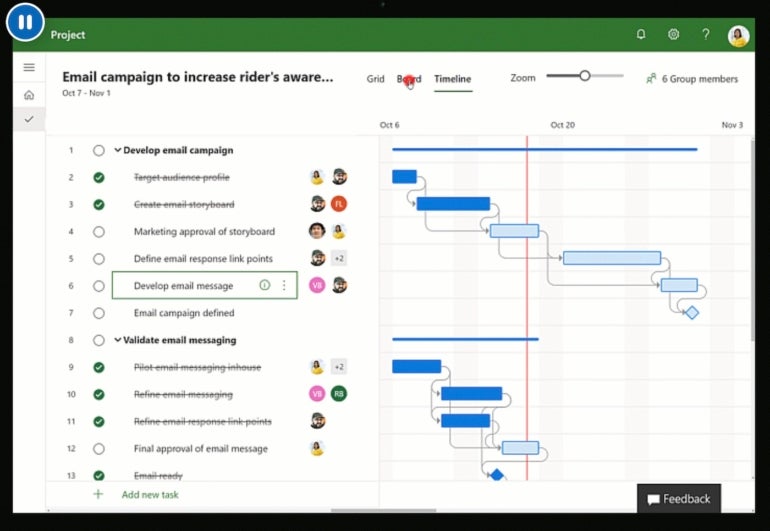
While Smartsheet is based on a spreadsheet’s grid-like appearance (Figure B), it also provides three other views: card (kanban), calendar and Gantt. You can either start with a blank sheet or use a template to help guide the process. Conditional formatting rules speed up the process even further, and you can also create automation rules to cut down on manual work.
Figure B
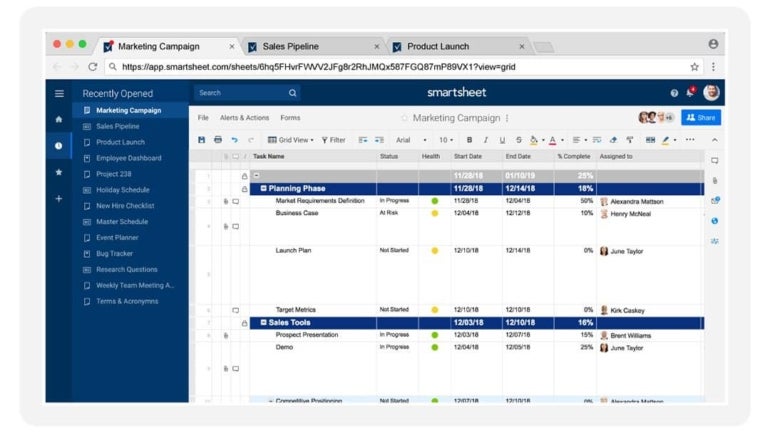
Document management
You can upload documents to a site in Microsoft Project, but editing and updating capabilities are limited. Instead, it makes more sense to use one of the Microsoft solutions that are dedicated to document management, such as SharePoint or OneDrive. This means that not everything will be stored in the same Microsoft product, and you will need a separate solution for document management.
Smartsheet allows you to upload files to a project, and it links to multiple popular document management solutions including Google Drive, Dropbox and OneDrive. The Business and Enterprise plans also offer a proofing feature that allows teams to visually mark up content, including videos, within the Smartsheet tool to keep everything centralized in one place.
Communication tools
Similar to document management, Microsoft Project does not contain any native features for communication or collaboration. Instead, users will be prompted to connect with colleagues using one of Microsoft’s many other communication tools, including Teams (Figure C), Outlook and Skype. If you aren’t already part of the Microsoft ecosystem, then you will need to invest in other software that can take over this function.
Figure C
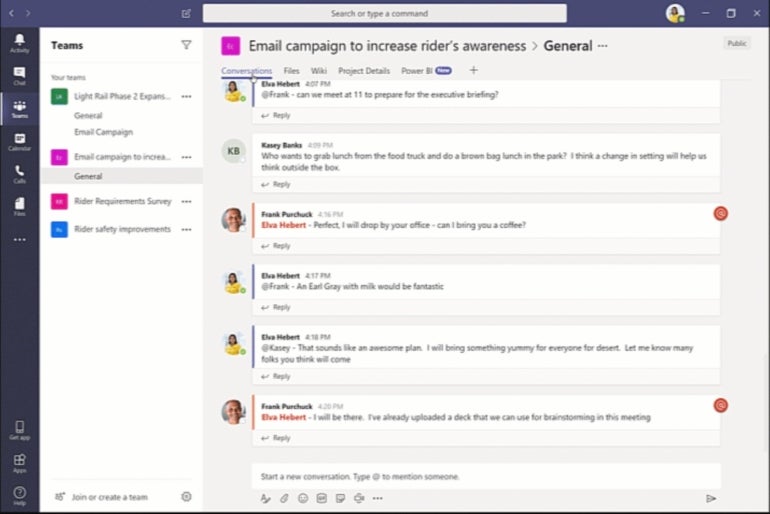
On the other hand, Smartsheet allows teams to have conversations via comments on sheets and rows; individuals can tag each other in comments to send a notification. Comments can even be accessed via the mobile app, so you can read and respond on the go. While it doesn’t offer a more robust native chat function, it does integrate with some messaging platforms such as Slack to supplement the built-in comment feature.
SEE: Looking for something a little more collaborative? See if any of these Smartsheet alternatives suits your needs.
Microsoft Project pros and cons
Microsoft Project pros
- Detailed project planning tools.
- Integrates well with other Microsoft products.
- Many resource management tools built into the software.
Microsoft Project cons
- Long learning curve due to all the complex features.
- Lack of integrations for non-Microsoft tools.
- No native communication tools.
Smartsheet pros and cons
Smartsheet pros
- Familiar user interface due to the spreadsheet base.
- High level of customization available.
- Lots of documentation and training resources.
Smartsheet cons
- Not as user-friendly and intuitive as other project management apps.
- No auto saving changes or loading project updates in real time.
- Must upgrade to the Business plan for time tracking and research management.
Review Methodology
To compare these project management tools, we viewed demo videos, consulted project documentation and read user reviews. When putting together our analysis, we considered factors such as price, ease of use, integrations and document management.
Should your organization use Microsoft Project or Smartsheet?
Microsoft Project is an extremely robust project management tool that is meant for experienced project managers who want to become power users and large teams with dozens or even hundreds of projects to track. Less experienced project managers or teams with fewer projects will likely be overwhelmed by the steep learning curve and complex interface.
Microsoft Project is also best suited to companies that are already part of the Microsoft ecosystem or in the process of migrating over to it. Microsoft Project assumes your team is already using other Microsoft products for key functions like team collaboration and document management. If you’re not, then it makes more sense to consider a different project management software that already incorporates these features.
On the other hand, Smartsheet is an excellent choice for smaller teams who are used to working in spreadsheets and want a more advanced project management solution that mimics this look and feel. It is much easier to learn than Microsoft Project thanks to its guided setup and extensive tutorials. However, the spreadsheet-centric design won’t work for everyone, and some users may find this design choice frustrating.
If neither Microsoft Project nor Smartsheet sounds right for you, don’t worry. There are plenty of other project management solutions out there, including some with forever free plans. Check out our picks for the best cloud-based project management software and the best enterprise project management software to see what your options are.
Featured Partners
1
Wrike
Tackle complex projects with Wrike’s award-winning project management software. Break projects into simple steps, assign tasks to team members, and visualize progress with Gantt charts, Kanban boards, and calendars. Manage resource allocation and forecasting with software that’s easy to launch. Automation and AI features strip away time-consuming admin tasks so you can do the best work of your life. Streamline your practices, align your team, and ensure you hit deadlines and stay on budget.
2
Smartsheet
Smartsheet is an online work execution platform empowering organizations of all sizes to plan, manage, automate, and report on work. Over 80,000 brands rely on Smartsheet for project and work management.
3
monday.com
monday.com Work OS is the project management software that helps you and your team plan, execute, and track projects and workflows in one collaborative space. Manage everything from simple to complex projects more efficiently with the help of visual boards, 200+ ready-made templates, clever no-code automations, and easy integrations. In addition, custom dashboards simplify reporting, so you can evaluate your progress and make data-driven decisions.
5
BigTime
BigTime is a leading Professional Services Automation (PSA) software that helps you scale your business by giving you the ability to track and act on your operational metrics. Even with remote work, easily manage time, expenses, and billing for multiple projects all at once, and quickly identify areas of opportunity with advanced features like resource allocation and custom reporting. With BigTime Wallet and client portal, you can get paid faster using custom invoicing and payment processing.
[ad_2]
Source link
